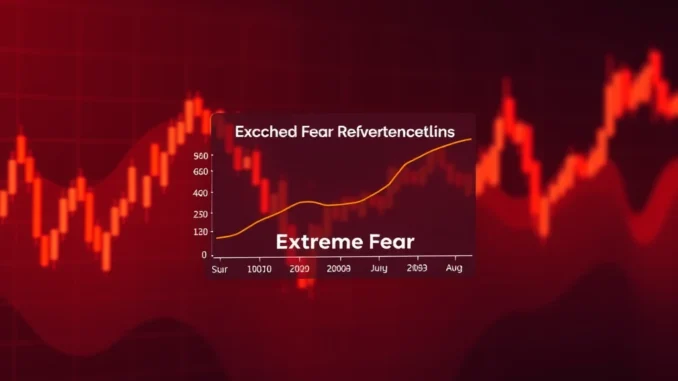
Navigating the turbulent waters of the cryptocurrency market can feel like an emotional rollercoaster. One key indicator that many crypto enthusiasts and seasoned investors keep a close eye on is the Crypto Fear & Greed Index. Recently, this crucial metric has shown a slight uptick, moving from 16 to 20. While this might seem like a positive shift, it’s essential to understand that the index remains firmly entrenched in the dreaded “Extreme Fear” zone. What does this mean for your crypto portfolio, and is there a silver lining amidst the fear? Let’s dive deep into the latest readings and decipher what the Crypto Fear & Greed Index is telling us about the current state of the digital asset landscape.
Decoding the Crypto Fear & Greed Index: What Does ‘Extreme Fear’ Really Mean?
The Crypto Fear & Greed Index, a brainchild of Alternative.me, serves as a sentiment compass for the often-volatile cryptocurrency market. It’s not just a random number; it’s a calculated gauge, ranging from 0 (Extreme Fear) to 100 (Extreme Greed), designed to reflect the prevailing emotions driving market behavior. A low score, like the current 20, signals extreme fear, suggesting investors are overwhelmingly anxious, potentially leading to undervaluation of assets and possible buying opportunities for the brave. Conversely, a high score indicates extreme greed, hinting at a market bubble and potential correction. But how is this index actually constructed?
The Six Pillars of Crypto Sentiment: How is the Index Calculated?
The Crypto Fear & Greed Index isn’t based on guesswork; it’s a composite of six weighted factors, providing a holistic view of market sentiment:
- Volatility (25%): Measures the current volatility and maximum drawdowns of Bitcoin, comparing it with the 30-day and 90-day averages. Unusually high volatility often signals fear.
- Market Momentum/Volume (25%): Compares current market momentum and volume to recent averages (30 and 90 days). High buying volumes generally indicate greed, while low volumes can suggest fear.
- Social Media (15%): Analyzes sentiment on social media platforms, primarily Twitter, for relevant crypto hashtags. High positive interaction can lean towards greed, while negative sentiment fuels fear.
- Surveys (15%): Conducts weekly crypto polls to gauge investor sentiment directly. While currently paused, this factor historically provided direct insights into market emotions.
- Bitcoin Dominance (10%): Tracks Bitcoin’s dominance in the overall crypto market. Increased Bitcoin dominance can sometimes indicate a flight to safety during fearful times, while decreasing dominance might suggest a risk-on attitude.
- Google Trends (10%): Analyzes Google Trends data for Bitcoin-related search queries. Spikes in searches like “Bitcoin price manipulation” often indicate fear, while searches for “buy Bitcoin” can suggest greed.
By combining these diverse data points, the Crypto Fear & Greed Index offers a nuanced perspective on the emotional climate of the crypto market, going beyond simple price movements.
Why Does Market Sentiment Matter in Crypto Investing?
Understanding market sentiment is crucial in the cryptocurrency world because emotions often drive short-term price fluctuations more dramatically than fundamental analysis alone. Here’s why sentiment, as reflected by the Crypto Fear & Greed Index, should be on your radar:
- Identifying Potential Buying Opportunities: Extreme fear can often present golden buying opportunities. When everyone is panicking and selling, assets can become undervalued. Contrarian investors often see “fear” as “opportunity”.
- Avoiding Market Tops: Conversely, extreme greed can be a warning sign of an impending market correction. When everyone is euphoric and buying, it might be time to be cautious and consider taking profits.
- Understanding Market Cycles: Crypto markets are cyclical, swinging between periods of fear and greed. Recognizing where we are in this cycle can help you make more informed investment decisions.
- Managing Risk: Sentiment analysis helps in better risk management. In times of extreme fear, you might want to reduce risk by holding more stablecoins or adjusting your portfolio. During greedy phases, you might consider rebalancing to manage potential overexposure.
However, it’s vital to remember that the Crypto Fear & Greed Index is just one tool in your investment toolkit. It should not be used in isolation but rather in conjunction with fundamental analysis, technical analysis, and your own risk tolerance.
Extreme Fear Persists: What Actionable Insights Can We Glean?
Despite a minor four-point increase, the Crypto Fear & Greed Index stubbornly remains in “Extreme Fear.” This persistent fear, even with a slight improvement, suggests a few key takeaways for crypto investors:
- Market is Still Fragile: The overall crypto market remains sensitive to negative news and prone to volatility. The slight uptick doesn’t necessarily signal a definitive shift to bullish territory.
- Potential for Accumulation: Extreme fear zones historically present opportunities to accumulate quality crypto assets at discounted prices. Consider dollar-cost averaging into projects you believe in for the long term.
- Exercise Caution: While opportunities may arise, caution is still warranted. Extreme fear can linger for extended periods, and further price drops are possible. Avoid impulsive decisions driven by short-term market fluctuations.
- Focus on Fundamentals: In fearful times, it’s crucial to double down on fundamental research. Identify projects with strong technology, solid teams, and real-world use cases that are likely to weather market storms.
Navigating the Fear: Is There a Silver Lining?
While “Extreme Fear” sounds ominous, it’s not all doom and gloom. In fact, for savvy investors, it can be a period of immense opportunity. Think of it this way: fear often leads to irrational selling, pushing prices down to levels that don’t reflect the true long-term value of assets. As Warren Buffett famously said, “Be fearful when others are greedy, and greedy when others are fearful.”
The slight rise in the Crypto Fear & Greed Index, even within the “Extreme Fear” zone, could be interpreted as a tentative step towards recovery. It might be the initial sign of fear starting to recede, albeit slowly. However, it’s crucial to avoid premature optimism. The market needs to demonstrate sustained positive momentum before we can confidently say that the fear phase is truly behind us.
Conclusion: Staying Informed and Level-Headed in the Face of Crypto Fear
The Crypto Fear & Greed Index serves as a valuable real-time pulse check on the emotional state of the crypto market. The current reading of 20, while slightly improved, firmly underscores that “Extreme Fear” continues to dominate. For investors, this means navigating with caution, but also recognizing potential opportunities that arise when fear prevails. By understanding the dynamics of market sentiment, staying informed, and maintaining a level-headed approach, you can make more strategic decisions in the exciting, yet often unpredictable, world of cryptocurrency. Keep an eye on the Crypto Fear & Greed Index, but remember to always do your own research and invest responsibly.



